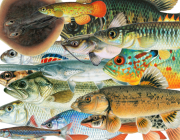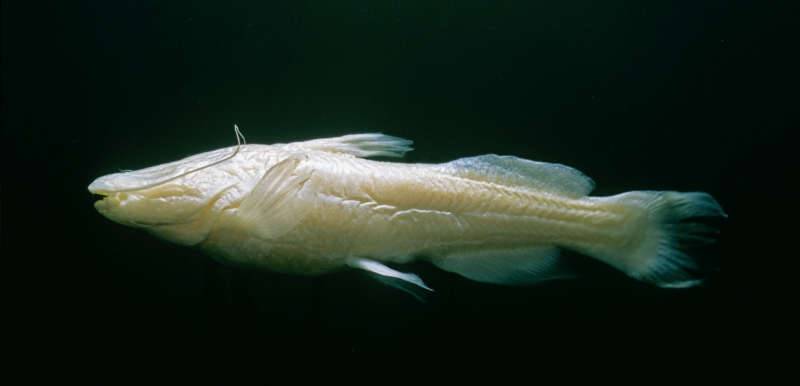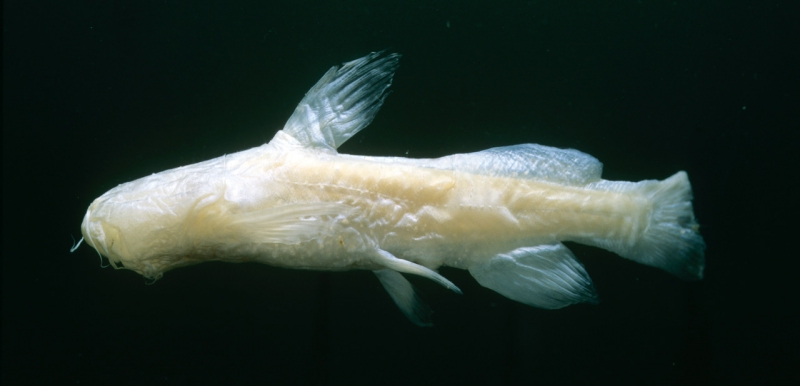|
|
|
| Satan eurystomus - Widemouth Blindcat (top - specimen is TNHC 21702) and Trogloglanis pattersoni - Toothless Blindcat below (middle - specimen is TNHC 21701). Both specimens held by University of Texas Biodiversity Center (Texas Natural History Collections). Photographs by Garold Sneegas (used with permission). The short movie below them is of the only blindcat ever known to survive being brought to the surface via a well. It was captured in the late 1970s by Dr. Glenn Longley, who kept the specimen alive in a well-fed laboratory at Texas State University in San Marcos, Texas. More detail on the specimen is available in his report (1979). Longley gave this digital copy of the original Super 8mm movie to Hendrickson in the late 1990s. Please cite these images/movie with the details provided here if used elsewhere. |
Note: updates relevant to these species may be found in the parent page for blindcats.
The deep pool of the Edwards Aquifer under the city of San Antonio supports not only a large and diverse human population that drinks its water, but also supports a remarkable subterranean aquatic ecosystem, likely the most diverse one in the world (Longley 1981). At the bottom of that ecosystem's foodchain are a bizarre little eyeless, toothless, pink suckermouthed catfish, Trogloglanis pattersoni, the fungal or bacterial mat it grazes, and there's a large number of diverse invertrates similarly adapted to the depth and darkness, that probably fall in the middle of the food chain. At the top of trophic system is Satan eurystomus, a toothy, predatory catfish with a wide mouth well designed to gulp in all of the many species of invertebrates (and probably small Trogloglanis as well). The biologists who described these bizarre fishes in 1919 (Trogloglanis) and 1947 (Satan), erected a new genus for each, recognizing their extreme morphological divergence and adaptations to their amazing habitat over immense periods of subterranean evolution. Trogloglanis means troglobytic (cave dwelling) catfish, and the species was named after the biologist who supplied the first specimen. The other genus recognizes the species' amazing, deep subterranean habitat (and perhaps its evil-looking, toothy gape), and the species name recognizes its impressively wide mouth.
The original description of Trogloglanis mentioned that blind catfishes were well known to issue from deep (300+ meters) artesian (natural pressure, so not requiring pumping) wells in the San Antonio area. Satan was described nearly 30 years later from very similar wells, and some wells have produced both species. Decades later, a systematic sampling program (Longley and Karnei 1979a and 1979b) found Trogloglanis to be markedly more abundant than Satan, and provided a solid inventory of the system's diverse invertebrates and their relative numbers. Recent attempts (Zara LLC 2010 and 2014) to replicate the sampling of the late 1970s caught Trogloglanis, but not Satan, and reported most of the invertebrates recorded in the 1970s, though some of those also seemed to have changed in abundance. Analysis of the highly unusual length frequency graph for both species provided by Langecker and Longley 1993, combined with Zara's conclusion nearly four decades later that Satan may be more rare now than in 1978, and Trogloglanis more abundant, combine to suggest multiple hypotheses about the population dynamics of what are almost surely predator and prey species. Such hypotheses could be testable using recently collected specimens to produce updated length-frequencies.
All wells producing these fishes are relatively near the "badwater zone" of the aquifer (https://doi.org/10.1130/2019.1215(12)), which likely provides the unique biochemical environment that has contributed to the evolution of these fishes. One would think that the very remote, deep and massive Edwards Aquifer that these fishes inhabit, and that San Antonio depends heavily upon for high quality municipal water, would be relatively hard to impact. However, the evidence to date supports the hypothesis that its biotic community has changed, and the "badwater line" that these fishes are close to (and upon which they may be highly dependent), is a complex, microbially-mediated evnironment potentially susceptible to changes in response to water level variations, which are heavily influenced by humans' management of the system and climate change. The general biotic health of the still very little-studied deep aquifer ecosystem merits further investigation, especially since its health is clearly linked to the health of the human population above it that depends on the same water.
These are both relatively small catfishes, compared to other members of the family. Langecker and Longley (1993) reported that the standard length of the 47 known specimens of T. pattersoni ranged from 16 mm to 89 mm and the 28 known S. eurystomus measure from 30 mm to 117 mm. Very little is known of their reproductive biology, but the only dissections (also by Langecker and Longley 1993) found no evidence of mature gonads in six specimens of Satan (51-90 mm), but as many as "200 oocytes at different stages of maturation (largest 0.5 mm)" in an 80 mm Trogloglanis and those >60 mm frequently had minute eggs. As for food habits, Trogloglanis stomachs contained only a mud-like substance and Satan's stomachs also contained crustraceans.
Conservation status of these rare fishes is debated. Most every non-govenmental list of threatened and endangered fishes (most recently that of the American Fisheries Society, Jelks et al. 2008) includes both, and there have been petitions to U.S. Fish and Wildlife Service to list both as endangered. The low number of specimens compared to other species tends to give the impression of rarity, but the response to those petitions has been that there's inadequate information available to make a determination. In the latest (1994) review, the status of both was declared "Unknown", which is defined as "...for those species where additional survey work is required to determine their current trends." Those determinations were made well before the most recent surveys that failed to detect Satan were done, and the results of those certainly give reason for pause. A re-assessment of the conservation status of both of these species is overdue, as the Center for Biological Diversity recently pointed out in a lawsuit.
Rarity and condition of specimens has inhibited research on these species for years, and so it's not surprising that the phylogenetic history of the two Edwards blindcats is still only vaguely know. Only 14 specimens of Satan can be found in the world's museums, and all were preserved in formalin, which prevents DNA extraction. Simlarly, DNA from Trogloglanis was unknown until a small specimen from the recent surveys (now in our collection as TNHCi 42586) provided tissues from which we sequenced DNA and also got a nice CT scan (see images below) . While the Cytochrome B sequence obtained from that specimen has not yet been fully analyzed, it has provided some surprises that require further research. More recently, tissue from the same specimen was used to extract its complete genome (Pirro, Stacy. 2020. “Trogloglanis Pattersoni - BioSample - NCBI.” NCBI Resources. April 18, 2020. https://www.ncbi.nlm.nih.gov/biosample?LinkName=bioproject_biosample_all&from_uid=626086.).
With failure of the recent surveys to produce DNA of Satan, we turned back to anatomy for insights into its evolutionary history. CT scanning, an amazing and non-destructive tool for examining osteology of such rare specimens, has greatly improved our knowledge of this species anatomy. Our paper (published on Halloween 2017) with detailed illustrations of Satan's skeleton discusses what CT scanning revealed about the species' evolutionary history. In the same paper we published many animations of Satan's skeletal anatomy that can be found in our blindcat Morphosource project and in the collection of supplemental files for the paper that we permanently archived in UT's ScholarWorks. Satan is also a topic in most of the presentations from our mini-symposium on blindcats at the 2017 Joint Meeting of Ichthyologists and Herpetologists that we hosted here in Austin.
But, despite all the new morphological insights, not unexpectedly, the true evolutionary history of this diabolic critter remains elusive. We won't stop hoping to get a sample of Satan's DNA, and if we ever do, we're well prepared, having DNA of all of the other three regional blindcats, to get much closer to the truth. And, if we ever do obtain DNA of Satan, that would allow us to use a new, very powerful tool for monitoring the species by looking not for specimens, but simply for its DNA in water. DNA of many of the incredibly biodiverse ecosystem of the deep Edwards Aquifer can be much more easily obtained than might be the case for Satan, and it's clear that the stability (or lack thereof) of that biotic community has great potential to serve as an indicator of the overall health of that ecosystem that, like humans, also depends on the continued high quality of the Edwards' water. With evidence mounting that the deep and remote world has been changing under the influence of humans and climate change (https://doi.org/10.1130/2019.1215(13), https://doi.org/10.1511/2019.107.5.260), we hope that those charged with managing that important resource promote research of its biota to help provide the best information possible to assure sustainable management of that strategic water supply for both humans and the aquifer's amazing biota.
Satan eurystomus in Fishes of Texas Project - map, species account, specimen list, blog post about the species and its habitat
Trogloglanis pattersoni in Fishes of Texas Project - map, species account, specimen list



